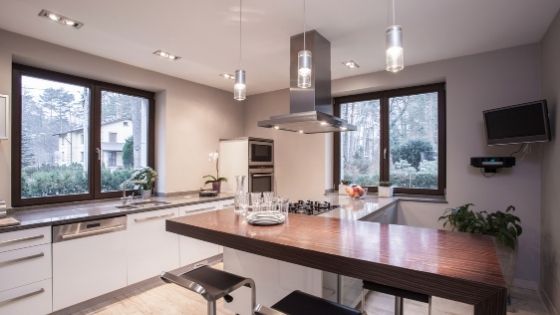The kitchen has become the heart of the home, and current designs lean towards an open concept. Insufficient planning when it comes to lighting is the most common oversight people make when designing these types of kitchen, which often results in poorly placed and inadequate lighting.
Since it affects the adjacent living space, kitchen lighting must be welcoming and ambient. A well-thought-out lighting plan will make a kitchen much more inviting and dynamic. Polaris Home Design can help you decide on the location of your lights, determine the amount of light required as well as the budget needed for each layer.


Layers to consider when planning your lighting design
1. Ambient
This consists of “pots” or “tracks” mounted in the ceiling and is intended to add warmth and comfort to make your kitchen space more inviting. Typically, ambient lights are arranged around the kitchen perimeter and provide “all-purpose” daytime lighting. Commonly laid out equal distances apart, ambient lights can also be used to highlight any architectural details.
2. Accent
Considered to be decorative, this level is intended to highlight design features – open shelves, hutches, art, glass door cabinets etc. To get a nice night-time lighting effect, accent lights can be placed in the toe-kick space below your base cabinets or underneath the countertop of a kitchen island.
3. Task
Customarily installed underneath upper wall cabinets, these need to be factored into the initial design as they can be expensive and difficult to install after modelling is complete. Even if your budget doesn’t allow for lights right now, you could consider fixing wiring junction boxes and add the fixtures later on.
When planning the location of your task lighting, consider where you’ll most likely be working close-up, such as the sink, food prep areas, islands, desks etc. For a modern finish, task lights could come in the form of chandeliers or pendant fixtures hanging over your island.









